Competing Genetic Algorithm Explained
Abstract
In this article I describe a Competing Genetic Algorithm that was created during my work on QGEN Project.
It was a project for the task of finding new profitable trading strategies in a financial market.
In this project by trading strategy I mean: a mathematical formula that uses some datasets of past market data and produces a number. If the number is positive we should trade LONG for a given instrument. If it is negative - we should trade SHORT. Otherwise - CLOSE any position.
At first, I describe well known Genetic Algorithm in details.
Then I show its limitations for tasks of particular kind, when you can expect many different good solutions. In this case a simple Genetic Algorithm will most probably stuck in a local optimum with one result.
Using analogy with some imaginary example I show the way to solve this problem: competition for resources.
Then I describe the proposed Competing Genetic Algorithm. Its main principles are:
- Evolve several species in parallel, each with its own population.
- Make species compete for resources with each other. This is achieved by adding a competing penalty (or regularizing) term into scoring function.
Genetic Algorithm
Genetic Algorithm is well known since 1960. It is used in optimization and search problems.
Particularly this project is a search problem. There is enormous space of all possible trading strategies, some of which are profitable, others are not.
Brute-force search through this space seems impossible.
This is a good task for Genetic Algorithm if we manage to set up all conditions for it to work.
Genetic algorithm requires several conditions to work:
- You must specify how to write down your formula as a sequence of ‘symbols’. Either of fixed or variable length.
- Most important: you must specify the scoring (or fitness) function for any sequence.
- You must specify mutate operation for any such sequence.
- You may also specify crossover operation for any two (three, four, …) such sequences.
As you will see later a sequence is not necessarily a string and symbols could be other than letters.
All living creatures on Earth have the same building ‘symbols’ for their DNA ‘sequences’:
- Adenine (A)
- Thymine (T)
- Guanine (G)
- Cytosine (C)
Four ‘letters’: A, T, G, C - are combined into sequences of any length that describe all organisms of our planet.
Why only four? Nobody knows… I bet it happened by chance!
But we are not obliged to repeat the same limitations for our simulated evolution! (Thanks to my friend Eldar Mukhamedzyanov for this idea)
We don’t need to emulate chromosomes, start/stop codons, complementary mRNA strands, or even codons themselves! Instead, we can use array or list as a sequence and use keywords as symbols.
Formula as sequence
As you know, any formula can be written as a sequence of symbols. Take, for example, a formula in LaTex format:
\sqrt{ \frac{ a ^ {2*x^3 - 5} } {(b*x - 5)}}
Which is equivalent of:
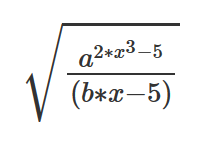
The problem with such string is in parenthesis. They make it hard to mutate or crossover sequences. As you can’t simply change any symbol in string in any place or dissect sequence at any random place.
Luckily there is a solution - reverse polish notation. It helps to get rid of parenthesis.
With it the formula sequence looks like this:
a 2 x 3 ^ * 5 - ^ b x * 5 - / sqrt
A good example of polish notation usage is the Postscript language, which you implicitly evoke every time when reading PDF file.
This language also introduced stack as a way to get rid of variables. Let’s see how our formula could look in a postscript-like language:
push a
push 2
push x
push 3
pow
mul
push 5
sub
pow
push b
push x
mul
push 5
sub
div
sqrt
After execution there will be one item on a stack, containing the result of this formula.
The same principle is used in this project.
In syntax.lua
you may find sequence generation, mutation and crossover operations.
And in processor.lua
you may find all operations.
Note: each line here should be treated like one symbol. For instance, when mutate, you can change
powtoaddormul, but notpowtopoZ. Now you understand why I’m using sequences, not strings.
I don’t use push command for operands like a, b or x. I use Val instead.
While constants are simply written without any push or Val.
I had some reasons to do it this way:
a Val 2 x Val 3 Pow Mul 5 Sub Pow b Val x Val Mul 5 Sub Div Sqrt
The string above should be treated like a sequence, a list of keywords. Each keyword representing a symbol, recognizable by the syntax processor.
Datasets
Instead of a, b and x in the previous example we need to operate some real market data.
This data in most cases comes as a time series.
That is why I use vectors as operands. Where first element of vector is the earliest one, and the last element is the newest one.
Datasets of past market data are as follows:
po: vector of open prices for intervals (10min, 1hour, 1day)ph: vector of highest prices for intervals (10min, 1hour, 1day)pl: vector of lowest prices for intervals (10min, 1hour, 1day)pc: vector of close prices for intervals (10min, 1hour, 1day)ptr: vector of price true range at intervals (10min, 1hour, 1day)vwap: vector of Volume-Weighted-Average-Prices for intervals (10min, 1hour, 1day)vol: vector of open prices for intervals (10min, 1hour, 1day)time: vector of close times for intervals (10min, 1hour), where each value is in [0..1] such that 0 = start of of trading session, 1 = end of trading session.
For more details dig into data.lua.
Operations
To build up any formula we need some operations. All operations could be divided into several categories:
- operations on a single operand
- operations on two operands
- stack control and other special operations
List of single operand operations: Delta, Min, Max, Sum, Prod, Rank, iRank, Std, SMA, WMA,
Neg, Abs, Sign, Exp, Log.
List of two operands operations: Add, Sub, Mul, Div, Mod, Pow, Min2, Max2, Covar.
List of stack control and other special operations: Swap, Dup, Rep, RepN, RepM, If, Lt, Lte, Gt, Gte.
Why there are so many operations?
Of course, some operations could be implemented as a sequence of other basic operations.
For instance: x 5 * can be written as x x x x x + + + +.
But my experiments show that it takes much longer time for genetic algorithm to get to solution when there are fewer operations possible. The longer the target sequence - the lower the probability to get it randomly.
It seems reasonable to have a good variety of operations. So your algorithm could easily find new solutions.
For details, you are encouraged to dig inside processor.lua.
Library of Sequences
I also developed additional approach to speed up evolution process. Some sequences are too large to wait for evolution to create them, but they seem to be useful in many trading strategies.
For example, the following sequence calculates body of candle, i.e. |close_price - open_price|:
pc Val po Val Sub Abs
Following example calculates the upper shadow of a candles:
ph Val po Val Sub ph Val pc Val Sub Min2
Next example acts like a filter that keeps only the first values of each trading sessions, zeroing other values out:
I time Delta 0 Lt Mul
I came to a solution when in some rare cases instead of a regular mutate operation genetic algorithm inserts random record from the library into a sequence.
This approach is wide spread in nature. As, for example, antimicrobial resistance could be caused by horizontal gene transfer. In this process microbes exchange some short portions of genetic information as a packages of DNA/RNA.
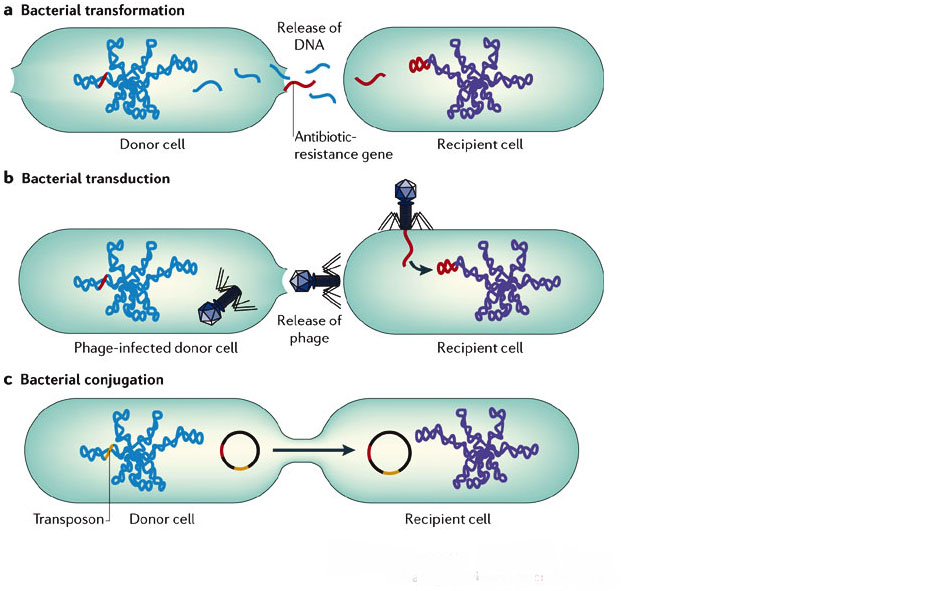 Image from (C) University of Leicester
Image from (C) University of Leicester
I believe that this method is helpful for my task though I didn’t perform any measurements to prove it. Please let me know your opinion, if any.
Genetic Algorithm and its parameters
Naive approach for genetic algorithm could be as follows:
- Start with initially random sequence.
- Measure the score of sequence.
- Mutate current sequence to get new mutant sequence.
- Measure the score of mutant sequence.
- If it is greater - then make it the current sequence.
- Goto 3.
The problem with such approach is that it usually requires more than one mutation to achieve next level.
For instance, deadly influenza virus H5N1 needs only 5 mutations to become transmissible through coughing or sneezing, like regular flu viruses.

This has not happened yet, because the probability for 5 exact mutations at once is low, though it is not impossible.
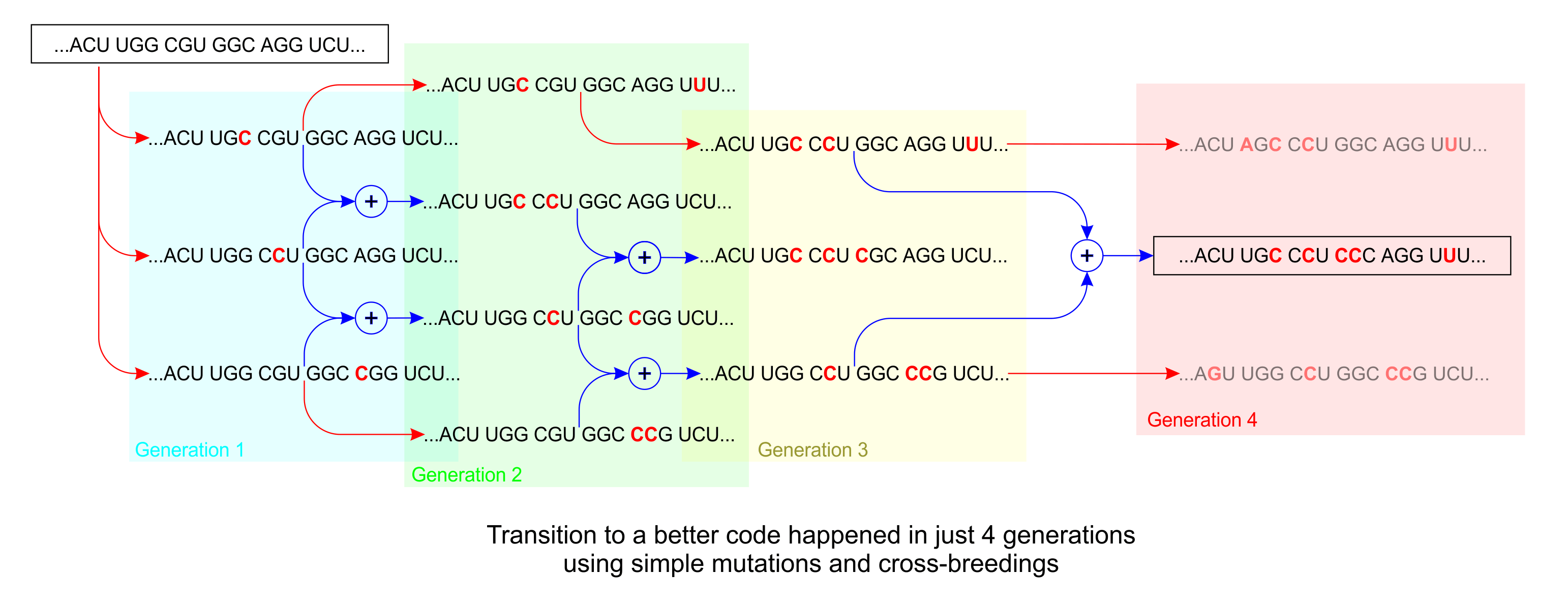
In order to speed up evolution we need to maintain variety of genes. That is why we need to work with not only one sequence, but with a population of sequences.
So our algorithm becomes as follows:
- Start with a population of initially random sequences.
- Measure the score of each sequence in population.
- Drop out the worst 10% of population sequences, keeping 90% others.
- Use remaining sequences to create new sequences via mutations and crossover, restoring the population to it’s predefined size.
- Goto 2.
For this algorithm you have to specify several parameters:
- population size,
- preservation rate,
- mutation factor.
Population size: the larger - the better the variety of genes. But large populations require more memory and computational resources.
What would be the optimal population size? I would say it strongly depends on your task. For example, there are still debates for optimal human population size. Choose according to your computing power available. Usually you can choose population size from 10 to 1000.
Preservation rate (90%) is adjustable parameter which determines speed of population renewal vs. genes preservation. If it is big the variety will be good. But when it is too big - the evolution slows down. I have found that values from 50% to 90% are good enough.
Mutation factor specifies the probability of any symbol to change when new sequences are created from existing using mutation operation.
Note that mutation factor does not have to be a constant value. I made it a function of overall score: the better the score the lower the mutation probability. So I start initially from 0.15 in the beginning down to 0.01 for ‘mature’ sequences.
Population size, preservation rate and mutation factor all together influence the speed of your evolution. I came to the conclusion that they don’t have to be precisely tuned to achieve good result. Evolution algorithm is pretty robust and can work in a wide range of these parameter’s values.
But in a worst case, when population size is too small, or preservation factor is too low, or mutation factor is too high, you may meet a genetic drift problem.
Genetic drift is a mechanism of evolution in which allele frequencies of a population change over generations due to chance (sampling error). Genetic drift occurs in all populations of non-infinite size, but its effects are strongest in small populations.
If you notice that:
- your population does not evolve;
- all sequences are very similar to each other (low diversity);
In this case you should adjust your parameters.
Limitations of Genetic Algorithm
The algorithm presented above is good enough for most cases. For example:
- to find best hyperparameters for neural network in a large space of possible values,
- to find strong and lightweight structural design of some element,
- to dynamically organize routing in telecommunication networks,
- for trip, traffic and shipment routing,
- to find 3D shape of long molecule,
- etc.
These are tasks in which you have a pretty good idea of what the result will be.
The task for this project (finding profitable trading strategies) however is more complicated. As it could have a lot of good solutions.
Take for example an imaginary world. It has some island with flies and grass, and algae in the sea. Flies, grass and algae - are available renewable resources.
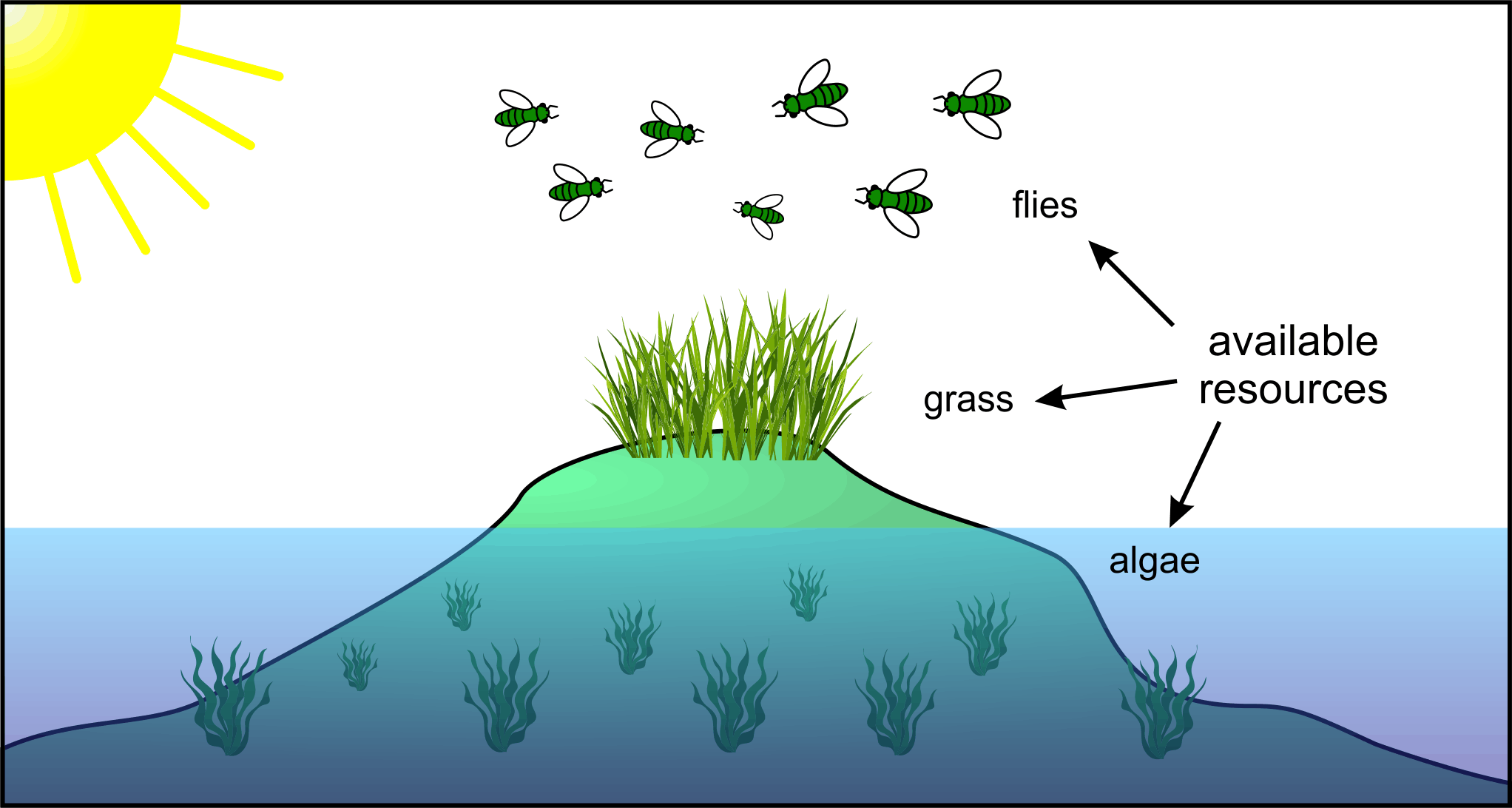
Say you want to use evolution algorithm to design a new creatures that could feed on available resources.
If you apply genetic algorithm presented above you will most likely end up with a creatures that could eat either grass or flies or algae, but not all kinds of resources.
Algorithm will quickly evolve creatures to consume any kind of resources and it will ignore all other kinds. It easily stops at local optimum and has low chances to escape from it. Evolution chooses the easiest way, not the best one.
You will probably never get a creature that could feed on all kinds of resources, like this:
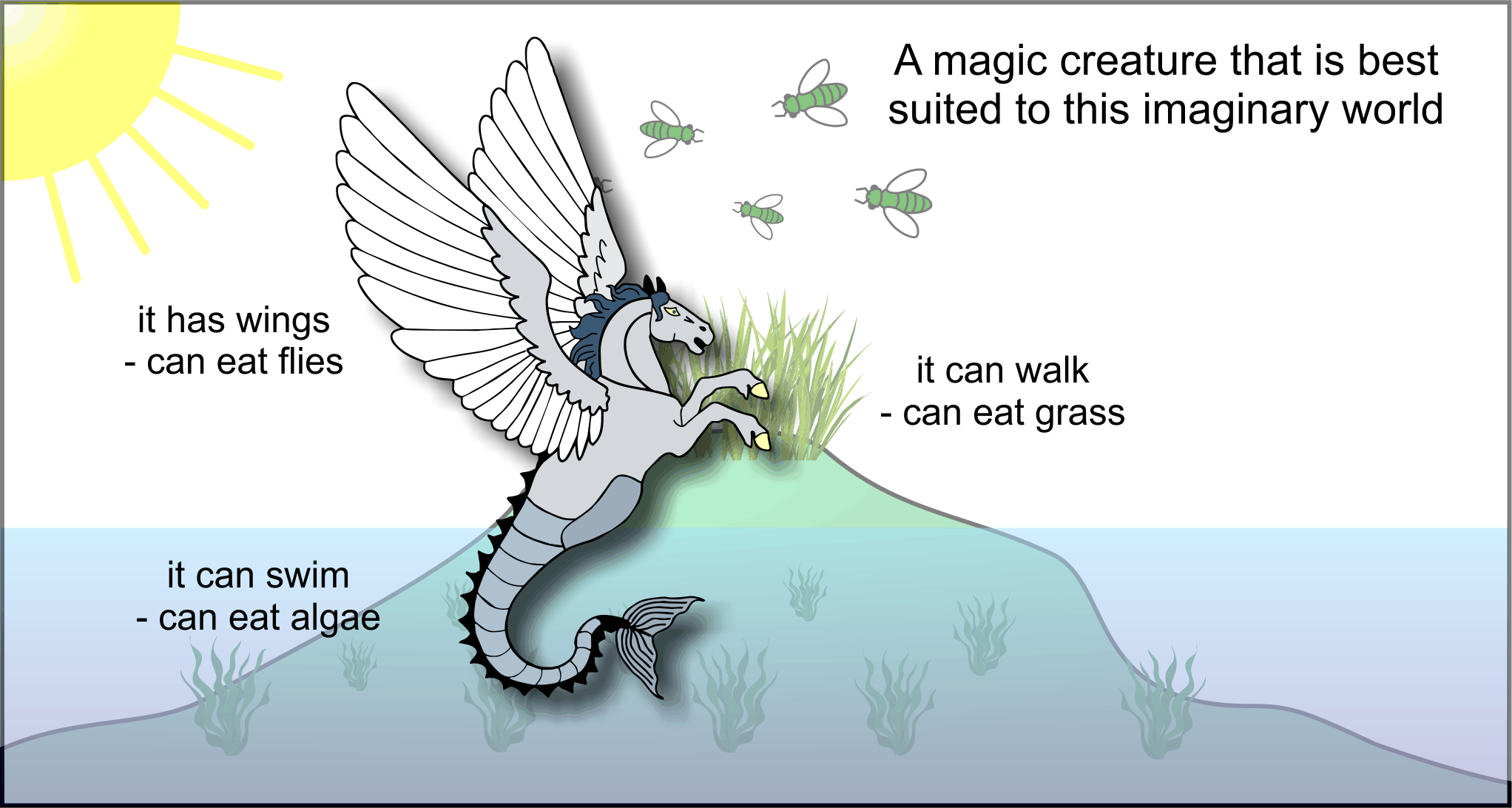
In the real world different organisms compete with each other for food to survive. This lead to development of large variety of species, where each specie specializes on a particular resource.
The best solution for this imaginary world would be to evolve different species in parallel while making them compete for resources.
Then we could, for example, get to a solution with three species: birds, cows and fish. Where:
- birds eat flies,
- cows eat grass,
- fish eat algae.
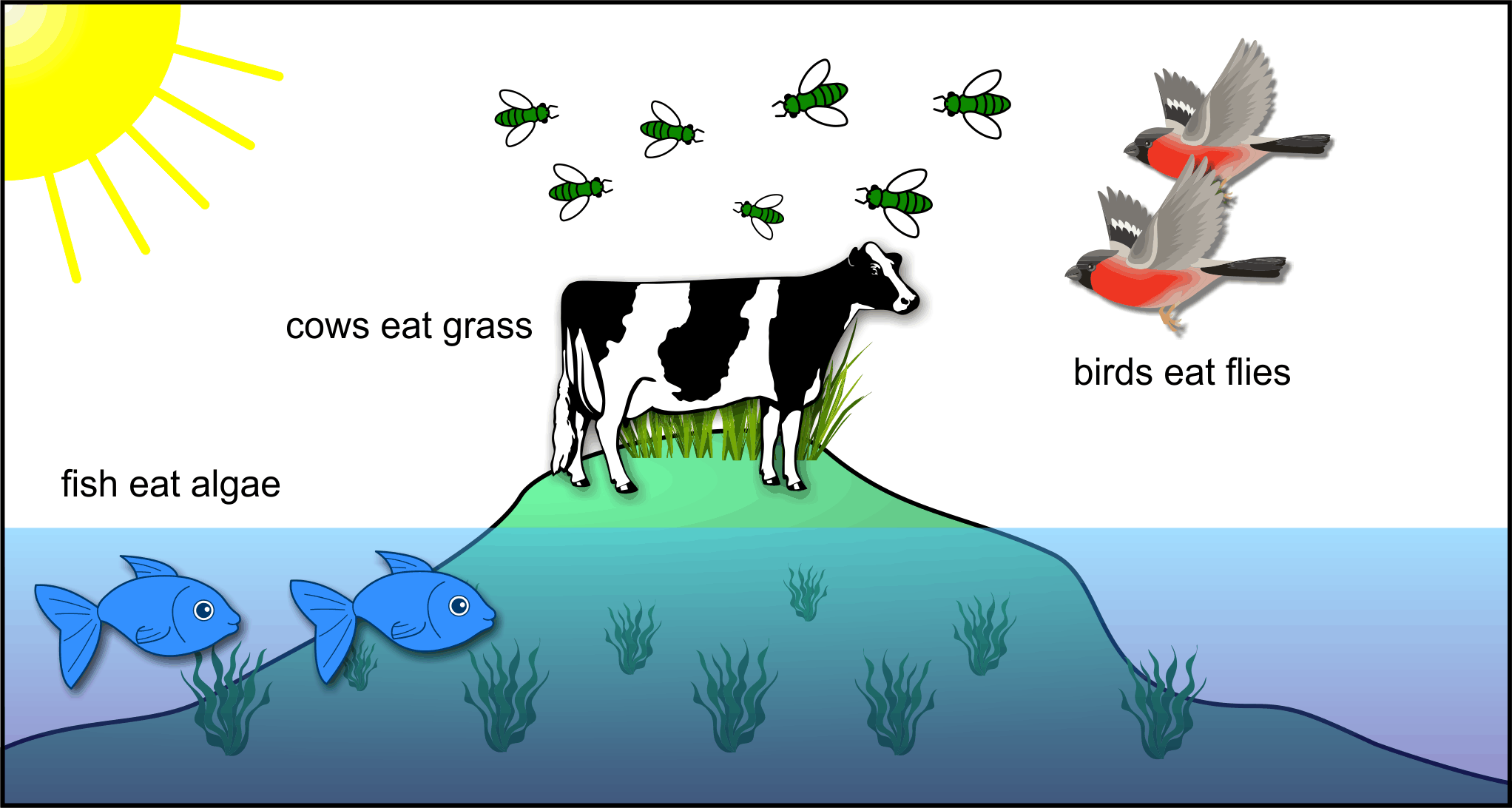
The same logic can be applied to finance market. There could be many profitable trading strategies (= resources). The problem is that described above simple genetic algorithm can lead you to one strategy only at one run. And if you make another run from scratch, it will most probably lead you to the same strategy again.
We need modified Competing Genetic Algorithm which evolves different species in parallel while making them compete for resources.
Competing Genetic Algorithm
In this algorithm we should evolve not only one population, but several species each with its own population of sequences.
After mutation and crossover operations, you should also specify a competing function, which compares behaviour of two sequences and returns a value in between [0…1]. Where 0 means that sequences use completely different resources, and 1 means both sequences use totally the same resources.
This competing function is needed to prohibit two species to use same resources. You can use it as a regularizing or penalizing term in overall score for each sequence, as follows:
- Compare behaviour of current sequence with behaviour of best sequence of each other specie and compute competition function for each pair.
- Use maximum result of competition function in a regularizing term to calculate final score of current sequence.
You can either multiply or subtract regularizing term to overall score:

or

where gamma is the weight of regularizing term.
The logic of this regularizing term is simple: when current sequence behaves like the best sequence of any other specie it means that they are using same ‘resources’. Then its score should be low.
Please note, that this regularizing term does not kicks out the specie, which had first took over this particular resource. Because we don’t compare each sequence with all other sequences in all species, but with the best sequences of each specie only.
It means that if any specie has evolved a formula to exploit some resource, then it is protected from future claims for this resource.
I.e. when later there in some other specie appears a new mutant that want to utilize the same resource, it is penalized by competing function and, most probably, is thrown away.
How to implement competing function?
It depends on your task and definition of its ‘resources’. For this project I used Pearson correlation coefficient.
Just to remind you: a trading strategy in this project is a formula that output a number for each time period. Hence we get a vector of numbers as a result of each sequence.
[ 12 11 4 0 0 -10 -5 -7 4 -5 0 0 ]
First we need to apply a sign function to this vector, as we need only the sign of a number:
positive means ‘BUY’, negative means ‘SELL’, zero means ‘CLOSE position’.
sign( [ 12 11 4 0 0 -10 -5 -7 4 -5 0 0 ] )
= [ 1 1 1 0 0 -1 -1 -1 1 -1 0 0 ]
Then we can calculate Pearson correlation coefficient for any two output vectors and use its absolute value as the result of competing function.
corr( [ 1 1 1 0 0 -1 -1 -1 1 -1 0 0 ],
[ 1 0 0 1 1 -1 0 -1 0 -1 0 1 ] )
= 0.538
Please note that you should manually treat special cases when vector contain all zeroes, or all 1 or -1.
Now the algorithm itself.
You can start with several species, each with randomly initialized population. But I suggest you would start with one specie, adding new species one by one, when old species have reached some level of maturity (= profitability in my case).
So, the proposed algorithm is as follows:
- If there are no species, or all species reached some required level of maturity (= min_score) then create new specie with randomly initialized population.
- For each specie:
- Perform simple genetic algorithm for each specie, running it for several generations. Spend more time (= cycles) for younger species with low scores, and less time for mature species with high scores.
- Save output signals of best sequence of each specie to be later used in competing function.
- During score calculation for each sequence take into account output signals from other species.
- Delete species that evolve for some long period of time (= iterations) but still have not reached required maturity (= profitability).
- Goto 1.
This algorithm is implemented in main.lua.
Note that it is designed to run in parallel in multiple instances
and it synchronizes different processes through file-locking mechanism.
This way it is able to evolve different species in parallel and speed up whole evolution process.
Scoring Function
The Competing Genetic Algorithm was not hard to invent and to implement. I’m almost sure that someone else had already published a similar algorithm under another name. (Do you know any?) As all ideas come from the evolution in the real world.
Its the creation of scoring function that was the hardest task in this project.
When I say: Evolution chooses the easiest way, not the best one, I mean: you will have to trace and close all the easiest paths to make evolution to work as intended.
What are these easiest paths?
If you did not remove trend from price time-series - the evolution will simply stick to this trend. After that it won’t try to find some other trading strategy.
If you have mistake in a dataset - be sure that algorithm will exploit it.
If you made a mistake in some operation - algorithm will find and exploit it.
When you have solved all errors in datasets and program codes, you can start adjusting the scoring function.
While does it need adjusting? Can I simply set:
Score(x) = NetProfit(x)
Well, unfortunately, no.
Because when you initialize random sequences they do not make any profit at all. They all contain logical errors and most of them could not be executed properly.
So you might want to support any sequence that perform at least some operations and has less computational errors:
Score(x) = NetProfit(x) + nOperations(x) - nErrors(x)
But the result would be disappointing, as genetic algorithm will quickly create a sequence that performs very large amount of operations without any errors… and without any profit too!
Because it is much easier to increase number of correct meaningless operations and get more scores, than to find any trading strategy and get more scores. And like I said: evolution chooses the easiest way, not the best one.
Then you may decide that nOperations should be around 10..100, not more. That nErrors is less important. And that Net Profit is the most important part of equation.
After that you realize that Net Profit is not the best way to score a trading strategy. That Profit Factor is better. And also Annual Rate and Max Drawdown.
You append a whole bunch of coefficients that specify the importance of this or that factor. So your equation quickly becomes large, unreadable and ugly.
But somehow I managed to make it work. Here is a short list of factors that influence the score:
- Annual Rate of Return
- Max Drawdown Percent
- Profit Factor
- nOperations should be about 10..100
- nErrors
- nTrades performed should be about 25..500
- sequence length is not too big
- sequence addresses to past data not too far away
- sequence outputs more than one item on stack after execution
Of course, do not forget about competition penalty term described above.
For details, you may dig inside score.lua
Running Evolution
This algorithm was applied to Moscow Exchange historical data.
Particularly: Futures for Sberbank stock (SBRF).
All settings for this instrument are located in SBRF/config.lua file.
For instance:
- Minial frame interval: 600 seconds (= 10 minutes)
- Population size: 100
- Species count limit: 70
- etc.
Creating datasets
Datasets are created from raw market data: history text files in CSV format with OHLCV values for 1 minute interval.
All history files can be found in history folder.
Since futures contract runs for a limited period of time there are 36 files for different contracts.
They cover period: Nov 2009 - Dec 2018.
But dataset is created only for the latest 24 contracts.
As in trading the recent data is valued the most.
You can create datasets with this command:
$ luajit data.lua SBRF
Changed dir to SBRF
Searching for history files...
Scanning ../history for history files...
Pattern=^SPFB%.SBRF%-(%d+)%.(%d+)%.txt$
Found 36 files:
../history/SPFB.SBRF-3.10.txt
../history/SPFB.SBRF-6.10.txt
../history/SPFB.SBRF-9.10.txt
...
../history/SPFB.SBRF-6.18.txt
../history/SPFB.SBRF-9.18.txt
../history/SPFB.SBRF-12.18.txt
Loading latest 24 files...
Loading ../history/SPFB.SBRF-3.13.txt...
55101/55101 loaded 49865 candles, 10370 frames, 928 hours, 68 days
Loading ../history/SPFB.SBRF-6.13.txt...
63966/63966 loaded 56065 candles, 11430 frames, 1003 hours, 73 days
...
Loading ../history/SPFB.SBRF-6.18.txt...
61708/61708 loaded 59576 candles, 12307 frames, 1096 hours, 80 days
Loading ../history/SPFB.SBRF-9.18.txt...
59820/59820 loaded 58763 candles, 12277 frames, 1113 hours, 81 days
Loading ../history/SPFB.SBRF-12.18.txt...
61686/61686 loaded 58630 candles, 12155 frames, 1087 hours, 79 days
Saving dataset to dataset.gz file...
Running evolution
When you run main.lua it starts Competing Genetic Algorithm.
$ luajit main.lua SBRF
Loaded library of 42 elements from library.dat
Loaded 197 names from names.dat
Changed dir to SBRF
Loading Dataset...
Loaded Dataset from dataset.gz
Dataset table: 24 array elements
Aquiring index...
Index has 70 records
Checking if all species are profitable... False
At this point algorithm takes a random specie - Urania
(I used viking and greek gods names to identify different species, see names.dat) -
and displays current info about this specie:
Opening urania ... Ok
specie info table:
annual_rate = 0.0032012154172002
annual_rate_std = 0.010049071912475
best_code = "I I I I I I I vwap fUp ... Lt Mul Neg Mul"
best_exec = "I I I I I I I vwap fUp ... Lt Mul Neg Mul"
best_rate = -0.006847856495275
best_score = -10147.275735904
best_serial = 9420
best_text = "fUp(vwap,15) 0.84771650492816 ... Lt Mul Neg Mul"
dataset_last_time = 1533934208
epochs_count = 15
iterations_count = 300
last_iteration_time = 1534031248
last_serial = 12200
max_drawdown_percent = 0.0038353712914283
max_proto_corr = 0.38551992908031
name = "urania"
profit_factor = 1.3446103287993
signal_neg = 0.0055944781884644
signal_pos = 0.00047131879392101
update_count = 1
Unlocking index
After that the script starts one epoch of evolution for selected specie:
----------
URANIA
----------
Initializing specie urania
Database has changed since last epoch. Purging cache...
Initializing competitors:
Processing specie 70/70
Initialized 62 concurrents
Calculating mean entity length:
Entities sequence length mean=40.72 std=3.6251344802641
Starting epoch of evolution (Autosave_Interval=2 Iterations_In_Epoch=20)
SBRF urania Iter: 301 Epochs: 15 Update: 0 Score: -10057.292644127 Winner: 70
SBRF urania Iter: 302 Epochs: 15 Update: 0 Score: -10057.292644127 Winner: 71
Autosaving specie urania
SBRF urania Iter: 303 Epochs: 15 Update: 0 Score: -10057.292644127 Winner: 72
...
I recommend to spend more computing time for new species with low scores and less time for mature species with high scores. I achieve this by adjusting the probability of selecting specie for next round.
You may run several scripts main.lua on one system.
Each scripts uses 2 CPU cores.
Say if you have 8 virtual cores - you can run 4 processes in parallel to achieve maximum speed of evolution on this PC.
As stated before, processes interact with each other using file-locking mechanism. That is why no two scripts could ever evolve the same specie at one time.
There is a special file: SBRF/index.dat which is regularly updated by running scripts.
It contains the latest information about all species and their best sequences with highest scores.
After many weeks of evolution there are in total 50 species (=trading strategies) with positive outcome, and 20 species which have not evolved to a positive outcome yet.
For example:
{
name='aphrodite',
best_score=419.3722137887,
best_code='pc Val po Val Sub I time Val vol I Delta vwap Val 0.6506024096 Gt Mul ptr Min 0.41427952546279 Gt time Val I I I vwap I I Rank ptr SMA Sub Days po Val pc Val Sub I I Days po Val time Delta 0.32497333249298 Lt Mul Rep po Max Sub Sub -0.0062526521217403 Gt Mul po Val 9.320244570715 pl Val Sub Delta 0 Lt Mul Sub 0.19505921812091 Lt Mul ph Hours Val Days po SMA Sub -0.35232823715884 Lt Mul 0.48087209546602 Lt Mul Mul Days vwap SMA 1.6236306970182 Mul ptr Max I I I I I ptr SMA Gt Mul Gt Mul 0.62809943857406 Gt Mul Rep pc Sum Hours oh Max I I I I I I ph I Val pl Val Sub Abs Add Gt ph Val I Days pc Val I Days po Val Sub 0 Gt Mul Rep Mul I RepN I I I I I I I I I time Val 0.59345924286126 Gt Mul Val ptr SMA Gt Mul I time Delta I time po Val pl Val Sub pc Val pl Prod Sub Log Min2 0.60342306191225 Gt Mul -0.24898811846294 Gt RepM',
best_exec='pc Val po Val Sub I time Val I vol Delta vwap Val 0.6506024096 Gt Mul ptr Val 0.41427952546279 Gt time Val I I I I I vwap Rank ptr Val Sub Days po Val pc Val Sub I I Days po Val time Val 0.32497333249298 Lt Mul Rep po Val Sub Sub -0.0062526521217403 Gt Mul po Val 9.320244570715 pl Val Sub Val 0 Lt Mul Sub 0.19505921812091 Lt Mul Hours ph Val Days po Val Sub -0.35232823715884 Lt Mul 0.48087209546602 Lt Mul Mul Days vwap Val 1.6236306970182 Mul ptr Val I I I I I ptr SMA Gt Mul Gt Mul 0.62809943857406 Gt Mul Rep pc Val Hours oh Val I I I I I I I ph Val pl Val Sub Abs Add Gt ph Val I Days pc Val I Days po Val Sub 0 Gt Mul Rep Mul RepN I I I I I I I I I time Val 0.59345924286126 Gt Mul ptr Val Gt Mul I time Delta I po Val pl Val Sub pc Val pl Val Sub Log Min2 0.60342306191225 Gt Mul -0.24898811846294 Gt RepM',
best_text='Val(pc,0) Val(po,0) Sub Val(time,1) Delta(vol,1) Val(vwap,0) 0.6506024096 Gt Mul Val(ptr,0) 0.41427952546279 Gt Val(time,0) Rank(vwap,9) Val(ptr,0) Sub Val(Days.po,0) Val(pc,0) Sub Val(Days.po,2) Val(time,0) 0.32497333249298 Lt Mul Rep Val(po,0) Sub Sub -0.0062526521217403 Gt Mul Val(po,0) 9.320244570715 Val(pl,0) Sub Val(0) 0 Lt Mul Sub 0.19505921812091 Lt Mul Val(Hours.ph,0) Val(Days.po,0) Sub -0.35232823715884 Lt Mul 0.48087209546602 Lt Mul Mul Val(Days.vwap,0) 1.6236306970182 Mul Val(ptr,0) SMA(ptr,9) Gt Mul Gt Mul 0.62809943857406 Gt Mul Rep Val(pc,0) Val(Hours.oh,0) Val(ph,15) Val(pl,0) Sub Abs Add Gt Val(ph,0) Val(Days.pc,1) Val(Days.po,1) Sub 0 Gt Mul Rep Mul RepN Val(time,21) 0.59345924286126 Gt Mul Val(ptr,0) Gt Mul Delta(time,1) Val(po,1) Val(pl,0) Sub Val(pc,0) Val(pl,0) Sub Log Min2 0.60342306191225 Gt Mul -0.24898811846294 Gt RepM',
best_rate=0.019430623099697,
annual_rate=0.050484096291059,
annual_rate_std=0.031053473191362,
max_drawdown_percent=0.014741135160058,
profit_factor=1.9935291706949,
max_proto_corr=0.46565787023241,
signal_pos=0.17645083955317,
signal_neg=0.12332460925269,
best_serial=124067,
last_serial=124200,
dataset_last_time=1533934208, -- 2018-08-11 01:50:08
last_iteration_time=1534195215, -- 2018-08-14 02:20:15
iterations_count=3100,
epochs_count=155,
update_count=3,
},
This trading strategy named ‘aphrodite’ has achieved following results:
- Annual rate of return: 5%
- Max drawdown: 1.4%
- Profit factor: 1.99
- Long signals: 17.6%
- Short signals: 12.3%
Results
Testing on historical data
Annual rates for trading strategies are in range 1%…5%, which is not much.
But if you combine different independent trading strategies your rate of return summarizes while overall drawdown gets lesser.
In order to test these strategies all together on a historical data you may run analyze.lua:
$ luajit analyse.lua SBRF
Changed dir to SBRF
Loading Dataset...
Loaded Dataset from dataset.gz
Dataset table: 24 array elements
Index has 70 records
Loading aphrodite...Yes
Loading vali...Yes
...
Loading astraea...Neg
Loading mokosh...Neg
Loaded 50 prototypes
Processing 24/24
## #trades Rate% DDown% PF RF
01 289 18.91 0.40 3.32 47.57
02 328 17.85 0.72 1.96 24.60
03 308 20.79 0.52 2.16 39.69
04 312 13.99 0.82 1.86 17.01
05 274 16.43 0.51 2.39 32.36
06 268 29.58 0.64 2.82 46.26
07 281 8.30 0.94 1.55 8.80
08 287 8.83 0.76 1.55 11.59
09 271 32.46 0.50 2.88 64.59
10 299 20.06 0.40 2.47 49.72
11 333 13.39 0.79 1.99 16.97
12 320 27.22 0.60 2.70 45.23
13 299 22.69 0.63 2.18 36.10
14 283 19.30 0.74 2.07 26.00
15 300 26.53 0.52 2.19 51.32
16 319 32.60 0.52 2.79 62.40
17 266 31.46 0.65 2.51 47.98
18 267 28.53 0.69 2.37 41.27
19 364 29.42 0.88 2.12 33.33
20 335 47.23 0.69 2.81 68.32
21 279 49.96 1.39 2.65 36.03
22 300 45.65 2.69 2.12 16.98
23 301 18.46 1.79 1.38 10.29
24 293 -3.76 3.71 0.94 -1.01
Average rate: 23.99
Please note that only mature (=profitable) trading strategies are loaded for this analysis.
There are 24 lines for 24 futures contracts. Each contract was virtually traded for about 3 months.
On each line you can see:
- Total number of trades during that period
- Annual rate of return
- Maximum drawdown
- Profit factor
- Recovery factor
It shows 24% average annual rate of return for trading with combined profitable trading strategies. While for some periods it was as high as 50%, and in the last period it is negative.
Trade testing on a real brokerage account
In Nov 2017 I have put about $800 onto my brokerage account and started a small trading script that executed trades through my broker’s API.
The result was disappointing. Initially it has shown some good profitability for about 40% annual rate. But later it started to slowly loose money.
I stopped experiment in July 2018 when there was only 1/4 of initial balance left.
During testing I tried to figure out why strategies show good result on history and fail in real trading. I’ve tested several hypothesis:
- Possible errors in source code that calculates profitability on historical data.
- Possible errors in source code that executes strategies on real-time market data.
- Commissions for trades.
- Slippage of orders execution due to delay of algorithm and broker’s API.
- Overfitting of strategies to historical data.
I double-checked source code and fixed all possible errors.
Commission for a trade of futures contract is very low: about $0.20 for Moscow Exchange. The number of trades is few orders of magnitude less than in high-frequency-trading. So commissions are not the reason.
Then I tested slippage. Slippage occurs when there is a delay from moment, when your algorithm made decision, to a moment, when this decision was executed. During this period price can change. Therefor your order will be executed by another price, usually worse than you expected.
Initially I believed that slippage has a negligible effect as I’m using 10 minute intervals. But when I added 0.1% slippage and tested on historical data again, I’ve also got negative rate of return! Thus slippage could be the main reason of such disappointing result.
Indeed, algorithm takes about few seconds to compute the next predicted position. Also there is about 1..2 seconds of my broker’s API delay for placing trade order.
The solution is obvious - you should include expected slippage in scoring function. Though it would require a lot of time (weeks) to evolve profitable trading strategies again.
I also came to a conclusion that genetic algorithm overfits to training data. This becomes obvious if you think about it:
- You run strategies on a particular historical data and compute scores.
- On each iteration you select sequences with highest scores.
- Thus sequences have no other way but to adapt to historical data they are trained on.
The question is: how to evolve strategies that generalize knowledge, but don’t overfit to the training dataset?
If you modify scoring function and performance of a trading strategy on a test dataset, then genetic algorithm will overfit to test dataset the same way.
I believe we can use here the same approach that is used in training of neural networks: early-stopping.
We can calculate performance of trading strategy on both train and test datasets. Performance on train dataset is used in scoring function, while performance on test dataset is not. If we plot those performances on one graph they should grow over time.
But if after some time performance on test dataset starts to decline - we should stop evolution of this trading strategy. As it probably starts to overfit.
This is how early-stopping could be applied to genetic algorithms.
Conclusion
Working on this project was really interesting, because I developed some new algorithm. But it was also challenging as there were no ready solutions in Internet.
I have found a way to apply Genetic Algorithm to a search problems, where you expect to find not one but many good solutions.
A proposed Competing Genetic Algorithm can evolve several solutions at once.
In order to apply Competing Genetic Algorithm to your problem you need to describe:
- solution as a sequence of symbols,
- mutation and crossover operations for sequences,
- scoring function for any sequence,
- definition of a ‘resource’ in your task,
- competing function for two sequences.
Algorithm has shown good results in searching for trading strategies for given historical data. It has evolved 50 trading strategies with annual rates from 1% to 5%.
Though discovered trading strategies showed poor results in real trade.
I came to the conclusion that main reasons for this are:
- slippage due to delay of algorithm and broker’s API,
- overfitting of trading strategies to historical data.
I believe that slippage was the main reason. While overfitting is not a mistake, but rather a natural behaviour for a genetic algorithm.
Slippage could be addressed by adding expected slippage percent into scoring function. Thus, re-evolving all species again.
Overfitting could be addressed by early-stopping technique.
What could be further improved for QGEN project:
- Modify scoring function to use expected slippage when calculating scores.
- Split train and test datasets like it is done for neural networks. Track learning curves. Use early-stopping technique to address overfitting.
- Single instrument’s price is not enough. Complete datasets with global market indicators like: S&P500 index, DAX index, manufacturing activity, retail sales, etc.
- Optimize operations.
Some operations are rarely used, for example:
RankandiRank- and could be easily removed.
